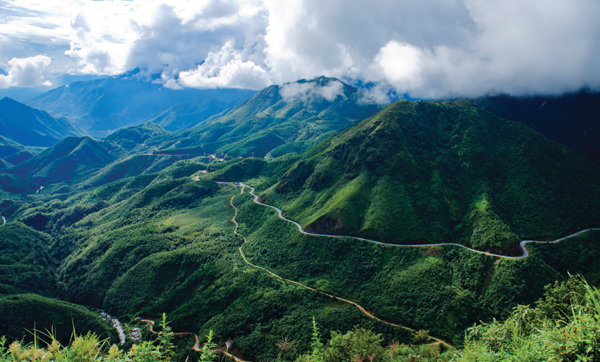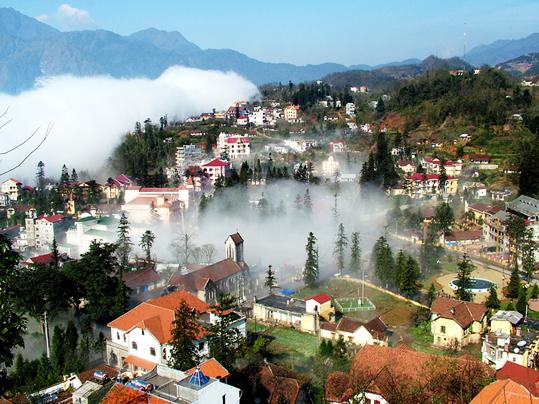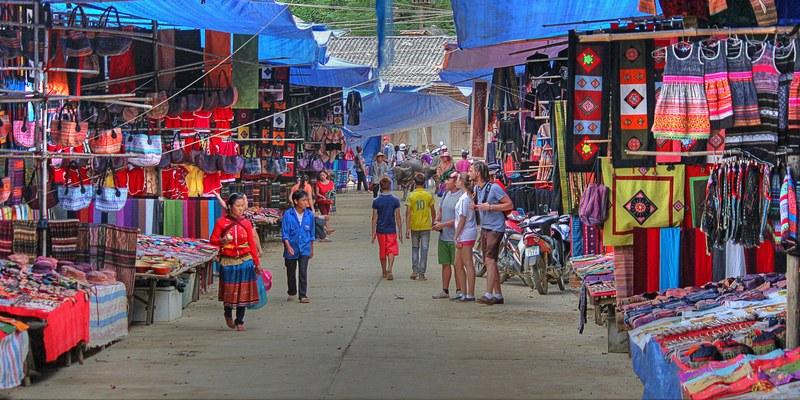Sapa, Vietnam

Lying in Hoang Lien Son Mountain Range, in the northwestern Vietnam, Sapa is famed for its authentic rugged scenery, mild weather and rich culture diversity. Sapa is graceful mountainous town where is endowed by picturesque mountains and rice terraces.
Sa Pa is located at the height of 1,500 to 1,650 meters on the mountainside of Lo Suay Tong. From the top of this mountain, we can see the southeast of Sapa with the height of 2228 meters.
Sa Pa enjoys temperate and subtropical climate with cool air throughout the year. One day, the town’s weather experiences 4 seasons: the morning is spring, the noon is likened to summer weather with mild sunshine, balmy climate; cool clouds and dew in the afternoon create a feeling of autumn weather and the night is the cold of winter.
The temperature averaging 15 to 18 degree census during best time of September to November; and March to May gains the heart of almost every relaxing vacationer. It is also home to many hill tribes with four main groups of Hmong, Yao, Tay and Giay ethnic minorities.
Arriving to Sapa, adventurous travelers should not miss the chance to challenge Fan Si Pang – the Mount Everest of Vietnam topping out at 3,143 meters. Also, they could trek various villages through paddy fields.
And one of distinctive culture when visiting Sapa is attending in Love Market which is normally held on Saturday nights.
Highlights of Sapa:
1. Pan Si Pan Mountain – located in Lao Cai province, about 9km southwest of Sapa town. It belongs to the mountain range Hoang Lien Son, located in the northwest of Vietnam and lying in the border of two provinces: Lao Cai and Lai Chau. It is the highest mountain of Viet Nam and the three indochinese countries with the height of about 3.143metters, it also called "The roof of Indochinese". Conquest of Fansipan is dream of many professional climbers as well as adventurous travelers when they come to Vietnam.
The top is accessible year-round to anybody, so long as they are in good shape, but be warned, the climb can be very tough, especially in adverse weather conditions.
Moreover,The flora in Fansipan is so diverse with 1,680 species of plants, some in which are rare and able to be found only here. Hence, the mountain is an appealing natural attraction for any tourists, especially the ones who are interested in botany.

2. Sapa Town - Nested under the shadow of Fansipan mountain, Sapa Town beautifully sits on a hill top at 1,600m above sea level, viewing over the Muong Hoa valley. Being unknown until 1880s when the French arrived Sapa town was quickly became well-known for its natural beauty, fresh and cool climate. As a result, in early decades of 20th Century, It was built into a summer resort by the French with some hundred villas to accommodate their colonials to escape away from summer heat of cities in lower regions.The resistant war against the French(1945-1955), caused a lot of damages and Sapa was almost isolated and forgotten until 1990s when tourism started again in Vietnam. Sapa woke up to welcome the first tourists in early 1990s and be developing into a large town to serve the booming tourism. Although experiencing such fast growing, the town is well maintained its own charms and resisted its harmony to the surrounding nature. From the top of Ham Rong Mountains a perfect panorama view of the town open wide with lovely architectures and buildings under the shades of pine trees which centered around the Church and market place.

3. Silver Waterfall (Thac Bac Waterfall ) – 12 km from Sapa to the west toward Lai Chau, you take approximately 30 minutes by motorbike or bus to visit one of the most beautiful waterfalls in Vietnam. The scenery along the way, the pine forest, and the 'su su' spread over the hills. With more than 100 meters high, white water poured down the stream. Especially, Arriving here, you can also soak in the cool stream, throw away all worries and relax under the shade of forest in order to all sorrows go with Silver flows.

4. Ethnic market day of Bac Ha – far from Lao Cai city about 60 kilometers. Bac Ha is the largest fair of Sapa. When going to market, you will see the high mountain, terraced fields. Sometimes, you have to stop the car in order to get the majestic natural beauty and meet each ethnic group laughing who brings goods to market. To go the fair on time, they have to go very early, some people comes here from the previous day to join the fair.
Bac Ha market is where all products of the region and the necessary instruments be traded colorful manmade commodities from various ethnic minorities in the town such as clothes, blankets, pillow cases.

5. Lao Chai & Ta Van Village - About 8 – 9 Km southeast of Sapa town on the west bank of Muong Hoa River, Lao Chai is a commune composed by three large villages with over 100 families of the Black H’mong ethnic. From a high point of the main road 8 Km from Sapa town, great view of the whole village open wide to offer the marvelous panorama of the village, backed by high mountains and facing the river. The H’mong people in this village experience rice intensive farming on the lower land near the bottom of the valley as main source of earning while growing corn on the mountain slopes at the back of the village.
Next to Lao Chai on the same side of Muong Hoa River is Ta Van village where the Zay and H’mong ethnic people live together. This is one of the best places to see the different traditional ways of living as well as cultural assimilation. Arriving Ta Van Village, you can reach by car, Jeep, mini van. However a trail up and down hill from Y Ling Ho through Lao Chai to Ta Van offers superb and romantic rout to hikers.
